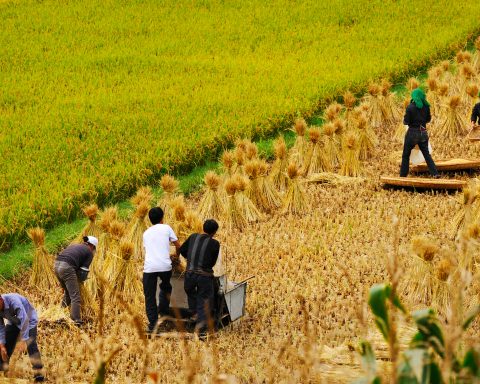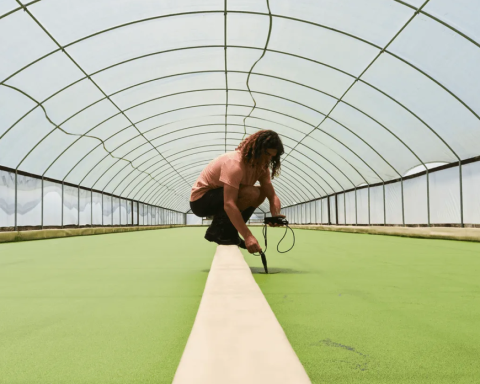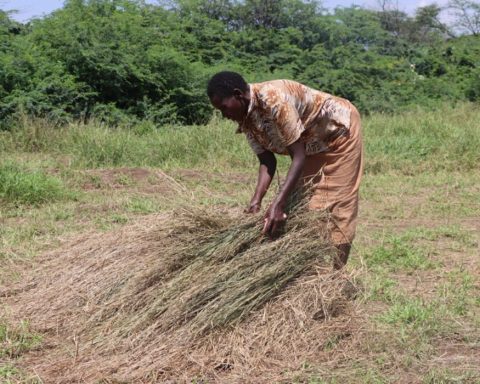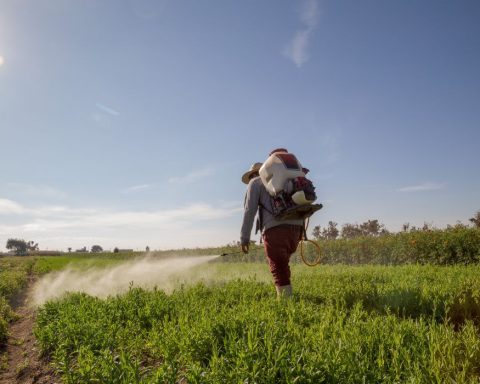Staring down Lake Michigan in Chicago’s south side is a stone archway with a macabre cattle head at its peak, one of a few remaining relics from a gruesome industrial past. It’s the centrepiece of the original Union Stockyards gates, opened in 1865 as the doorway to a sprawling 320 acres of livestock pens, abattoirs and rail operations. By 1900, it had swelled to 475 acres and was said to be the largest livestock operation in the world.
It was also the birthplace of industrial meat, where fateful new methods permanently changed how beef, pork and poultry were produced and transported, and evolved into what is now called factory farming. Namely, refrigerated train cars enabled a nationwide supply network, and production (once local and small-scale) was highly centralized by the biggest four meatpacking companies. A surge in output relied on the abundance of a cheap, desperate and largely immigrant workforce that included children. Production lines had been effectively de-skilled through division of labour (the “disassembly line”), and workers lived in unsanitary, crowded slums on the outskirts of the stockyards.
In 1904, the young socialist Upton Sinclair spent seven weeks in Chicago’s stockyards making notes on the squalid working and living conditions. The result was The Jungle, a novel about a Lithuanian immigrant’s journey through Chicago meatpacking. The Jungle made it to the desk of President Theodore Roosevelt, who used its stomach-turning descriptions of unsanitary meat being shipped out to Americans to push food-safety legislation. In 1906, Congress passed the Pure Food and Drug Act and the Meat Inspection Act, thus beginning the era of federal food inspection.
Roosevelt’s bills overlooked Sinclair’s primary aim, however, which was to improve the lives of workers. Eventually, after decades of organizing, unions grew stronger, and the dream of The Jungle looked more like reality. Between 1960 and 1980, meatpacking wages ranged from 15% to 19% higher than average manufacturing wages. The “big four” controlled only 20% of the meat market. But the 1980s saw the beginning of a gradual backslide, with production moving from urban centres to union-weak rural areas, line speeds increasing and wages falling. From 1952 to 2020, the percentage of workers covered by union contracts went from about 90% to 18%. Today, the new big four command more than 80% of the market.
Now almost 120 years after The Jungle was published, industrial meat has yet to find the balance between profit and worker well-being.

The most dangerous industry
In the early hours of the morning shift at a Virginia poultry factory in February 2022, a 14-year-old Guatemalan boy had been cleaning a machine that suddenly turned on and pulled him by his shirt sleeve along a conveyor. His forearm was then torn open down to the bone by plastic machine teeth. He survived the incident, undergoing several surgeries and months of physical therapy. Then in July, a 16-year-old worker was killed after being pulled into a machine at a Mar-Jac Poultry plant in Mississippi. The teens were among thousands of migrant youth illegally working dangerous jobs in the United States, many for sanitation companies where they would clean dangerous equipment like bone saws and head splitters. At the Virginia plant, minors were falsifying papers to get hired by Fayette Janitorial, the cleaning company contracted by Perdue Farms, then working overnight and attending school during the day, exhausted.
The U.S. Department of Labor announced an investigation into Perdue and Tyson Foods, two of the country’s largest poultry producers, and in February of this year asked a federal court to issue a temporary restraining order against Fayette while it investigated the company’s labour practices. This followed Labor Department penalties last February of US$1.5 million against Packers Sanitation Services, which was found to employ more than 100 children illegally in eight states, including at plants owned by JBS, the world’s largest meat company.
The New York Times called the situation “a new economy of exploitation,” but it’s only the latest chapter in the meat industry’s history of worker hazards.
For the last two decades, groups like Human Rights Watch and Oxfam have been sounding the alarm about high injury rates, insufficient regulations, suppression of collective bargaining rights, and the growing reliance on vulnerable migrant and undocumented workers largely powerless to demand better conditions. High line speeds are cited by workers as the main source of danger, causing them to cut themselves or develop musculoskeletal disorders. Gail Eisnitz, author of Slaughterhouse, reported Bureau of Labor Statistics showing “nearly thirty-six injuries or illnesses for every hundred workers,” making meatpacking “the most dangerous industry in the United States.” Eisnitz called meatpacking workers “an army of walking wounded.”
Horror stories occasionally spark public awareness of the meatpacking world, but the industry quickly returns to obscurity. 
In April 2020, the COVID-19 pandemic brought the vulnerabilities of meat workers into clear relief, once again. Amid plant closures, looming meat shortages and rising infections and deaths, President Donald Trump signed an executive order using the Defense Production Act to compel meatpacking facilities to remain open. Following this, 15 large poultry plants received U.S. Department of Agriculture approval to increase line speeds from 140 to 175 birds per minute. The Occupational Safety and Health Administration (OSHA) received a spike in worker complaints.
In June 2023, the U.S. Government Accountability Office released a report that found COVID-19 infection rates in meatpacking facilities up to 70 times higher than the general population due to the crowded nature of the workplaces.
Canada didn’t fare well, either. By May 2020, the single-largest COVID-19 outbreak site in North America was a Cargill meatpacking plant in High River, Alberta, where 950 cases had been recorded (out of 2,000 workers), and two deaths. The union representing the plant’s workers filed a complaint of unfair labour practice and requested a stop-work order, but the plant reopened after a brief closure, with a majority of workers reporting concern for their safety. A class action lawsuit against Cargill is ongoing.
Canadian meat workers also face the grinding pressures of speed and output. David Magina, a former inspector with the Canadian Food Inspection Agency, says he inspected chicken carcasses at line speeds of three birds per second (280 per minute). Even with the benefits of being a federal employee, Magina felt the deleterious effects of the environment. “My life is more important than any amount of money,” he says. Magina developed severe asthma, contracted a pathogen and suffered frequent headaches. The line workers he became friendly with regularly reported carpal tunnel syndrome, shoulder pain and eye strain.
Magina’s tenure in slaughterhouses also triggered what may be the most inadequately addressed hazard of working in the meat industry: post-traumatic stress disorder. “I saw unimaginable things. Standard industry practice is horrific, but I’ve seen even more extreme things.” People working the kill floor in particular become “shells of themselves,” Magina says. Studies have found that slaughterhouse workers experience higher rates of depression, anxiety and negative coping behaviour such as aggressiveness, substance abuse and domestic violence. The often vulnerable economic and cultural position of these workers means they cannot access sufficient mental health support – many lean on their communities for relief.
The industry keeps looking to temporary foreign workers (TFWs) to fill its labour shortages. In 2022, Employment and Social Development Canada announced a temporary increase on the cap of how many TFWs can work at a specific work location in certain sectors (including meatpacking), from 20% to 30% (after a previous limit of 10%). In 2020, the U.S. Citizenship and Immigration Services extended its own TFW program by three years so that producers could retain workers whose visas were expiring.
Some say we’re looking at the problem all wrong. Instead of putting economic migrants in dangerous jobs, should we be creating a labour market that uplifts precarious workers and doesn’t put them in harm’s way?

A way out
“Nobody dreams of working in a slaughterhouse,” says Kendra Coulter, a University of Western Ontario professor who studies labour involving animals. Coulter says that while unions can increase wages and improve conditions marginally, “they will never fundamentally improve slaughterhouse work.” The focus, she says, needs to be on the creation of humane jobs that are good for people and good for animals.
A recent report by the Stockholm Environment Institute suggests that a just transition for meat workers start with the Global North. Scaling down industrial meat could reduce environmental and health impacts, especially for communities exposed to the pollution associated with factory farms. However, the report cautions that a transition away from industrial meat will have “strong repercussions for communities where large numbers of people derive their livelihoods from meat supply chains.” While the plant-based sector could create more high-skilled jobs in certain regions, policy-makers will need to prioritize “the meaningful participation of marginalized groups,” groups that are often left behind in big industrial turnovers, like when auto and coal producers vacate regions.
The UN Environment Programme and investor network Farm Animal Investment Risk and Return (FAIRR) have also recently called for a just transition for meat workers. “Although no silver bullet exists for this sector” FAIRR says, “a just transition for food systems must be on the agenda for investors and policymakers alike.”
For workers seeking near-term relief, one possible answer might be more initiatives like Brave New Life Project, a volunteer-run non-profit that supports Colorado meat workers aiming to find new opportunities. Not an employment agency, Brave New Life is more of a holistic support network that assists with job-seeking and works with clients to find housing and food support, or obtain new job skills.
Although no silver bullet exists for this sector, a just transition for food systems must be on the agenda for investors and policymakers alike.
– Helena Wright and Stephanie Haszczyn, FAIRR
“One employment agent made a worker feel guilty about wanting to leave,” says co-founder Jessi Geist, referring to the JBS plant in Greeley, Colorado. It’s just one of many barriers workers face when seeking a way out. “If immigrants have a low baseline of English, slaughterhouse work is all they can get,” Geist says. Other trade-offs like taking wage cuts for less stressful work, or upending their homes to relocate, are not always options for people supporting families. “Is my mental health more important than my family?” It’s a question workers often ask themselves, Geist says.
Putting workers in better positions is key for Brave New Life. “Our long-term goal,” Geist says, “is to buy a piece of land, have people cultivate it, learn business skills, sell their products and become landowners themselves.”
After an injury makes him unhirable in the stockyards, The Jungle’s central character finds work at a fertilizer plant. The fertilizer, it turns out, is toxic and deadly. Even today, it’s still not as simple as just getting out.
Christopher St. Prince is a Toronto-based journalist and fiction writer.
This story is part of our Spring 2024 Plant Power package.






